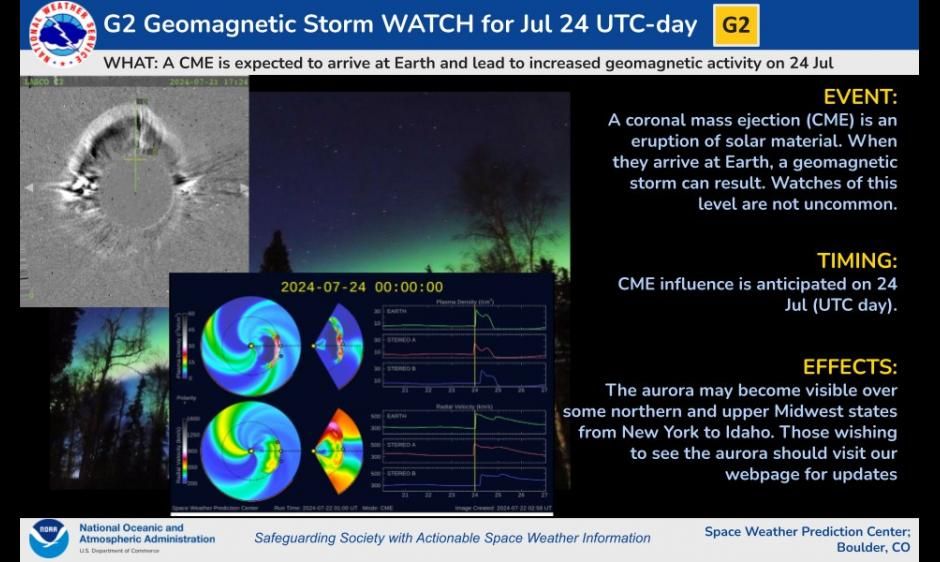Heightened solar activity has prompted the National Oceanic and Atmospheric Administration (NOAA) Space Weather Prediction Center to issue a geomagnetic storm watch for July 24. This alert comes as a result of a coronal mass ejection (CME) released from the sun on July 21, which is expected to reach Earth on July 24.

What is a Coronal Mass Ejection?
A coronal mass ejection (CME) is a massive burst of plasma and magnetic field from the sun’s corona. When a CME reaches Earth, it can interact with the planet’s magnetosphere, potentially triggering geomagnetic storms. These storms occur when ions from the CME collide with gases in Earth’s atmosphere, releasing energy in the form of light. This phenomenon is known as the aurora borealis (northern lights) in the Northern Hemisphere and aurora australis (southern lights) in the Southern Hemisphere.
Timing and Intensity of Geomagnetic Storm
Predictions suggest the CME will arrive in the early hours of July 24, though there is some uncertainty about the exact timing. Space weather forecasts can be tricky due to the dynamic and unpredictable nature of solar wind and magnetic field interactions. Space weather physicist Tamitha Skov noted on X that the storm might be delayed due to slow solar wind and an additional glancing storm ahead of it, which could potentially alter the arrival time of the CME. This variability highlights the challenges faced by scientists in accurately predicting space weather events, as even slight changes in solar wind speed and direction can significantly impact the timing and strength of geomagnetic storms.
NOAA classifies geomagnetic storms using a G-scale, ranging from G1 (minor) to G5 (extreme), based on the severity of their potential impacts. The current watch is classified as a G2-class storm, indicating moderate intensity. A G2-class storm can cause auroras to be visible at lower latitudes than usual and can potentially affect high-altitude power systems and spacecraft operations. While not as severe as higher-class storms, a G2 storm still requires close monitoring due to its potential to disrupt communications and navigation systems. As the predicted arrival time approaches, NOAA and other space weather monitoring agencies will continue to refine their forecasts and provide updates to ensure preparedness for any impacts.
Impact of Geomagnetic Storms
While aurora enthusiasts hope for a spectacular display, CMEs can have significant impacts on technology and infrastructure. On Earth, they can cause surges in electrical currents, potentially overloading power grids and causing blackouts. They can also disrupt radio transmissions and increase radio static in the ionosphere.
In space, high-energy particles from CMEs can damage satellites in low-Earth orbit and cause Earth’s atmosphere to expand. This expansion creates additional drag on satellites, which can slow them down and lower their orbits. Astronauts in space are also exposed to higher levels of radiation during CME events, though they are largely protected by the magnetosphere and the spacecraft.
Monitoring and Prediction
Geomagnetic storm warnings like this are not uncommon and can sometimes result in minimal effects. These warnings are issued regularly due to the sun’s continuous activity, including solar flares and CMEs, which can occasionally interact with Earth’s magnetosphere. In many cases, the impacts of such storms are mild, causing only minor disruptions to communication systems and producing beautiful auroras. However, the potential for more significant effects means that these warnings are taken seriously by scientists and space weather forecasters.
As July 24 approaches, space weather forecasters will have a better understanding of the CME’s impact and arrival time. The closer the CME gets to Earth, the more data scientists can gather from satellites and ground-based instruments, allowing them to refine their predictions. This improved understanding will enable more accurate forecasts regarding the timing, intensity, and duration of the geomagnetic storm. Forecasters will closely monitor changes in solar wind speed, density, and magnetic field orientation, as these factors play critical roles in determining the storm’s effects on Earth.
Conclusion
The upcoming geomagnetic storm presents both a potential visual spectacle and a reminder of the sun’s influence on our planet. As we prepare for possible northern lights as far south as New York, it is also crucial to stay informed about the potential technological impacts of such space weather events.








